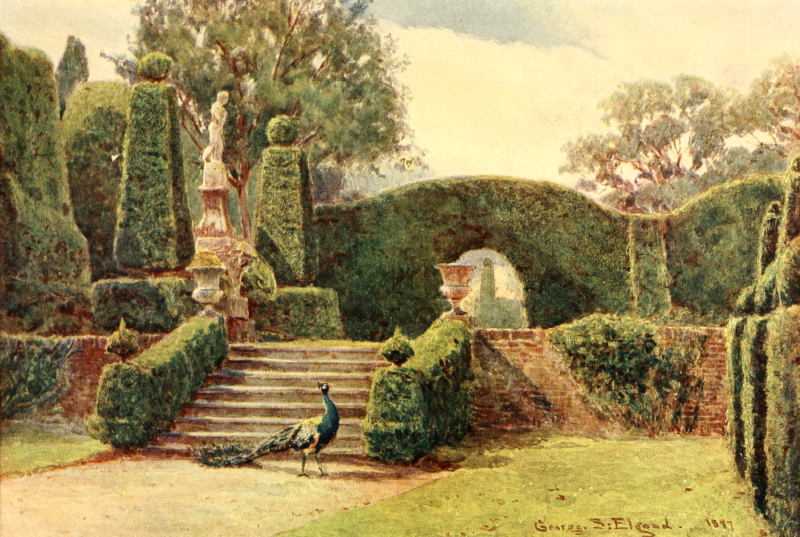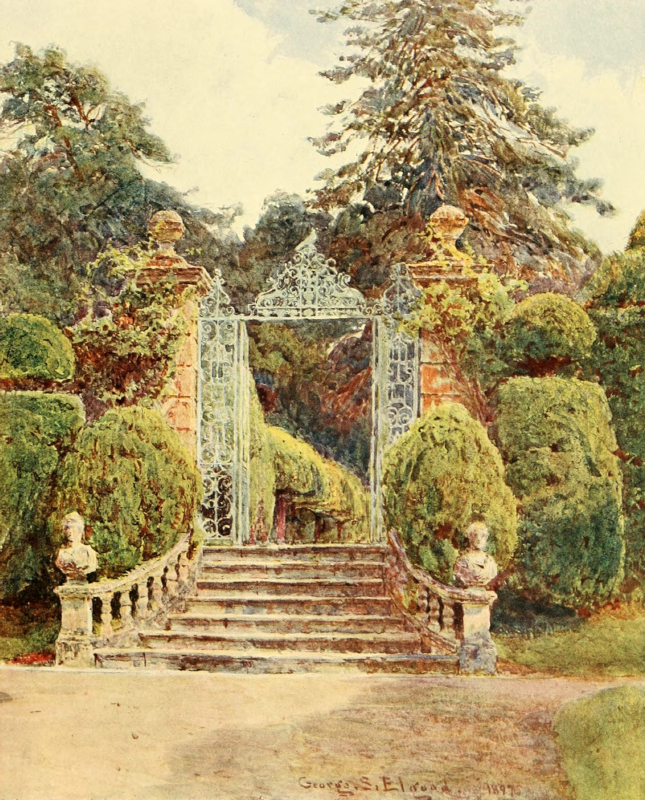| Web
and Book
design,
Copyright, Kellscraft Studio 1999-2021 (Return
to Web
Text-ures)
|
 (HOME)
|
|
BROCKENHURST
The English
gardens in which Mr. Elgood delights to paint are for the most part those that
have come to us through the influence of the Italian Renaissance; those that in
common speech we call gardens of formal design. The remote forefathers of these
gardens of Italy, now so well known to travellers, were the old
pleasure-grounds of Rome and the neighbouring districts, built and planted some
sixteen hundred years ago. Though
many relics of domestic architecture remain to remind us that Britain was once
a Roman colony, and though it is reasonable to suppose that the conquerors
brought their ways of gardening with them as well as their ways of building,
yet nothing remains in England of any Roman gardening of any importance, and we
may well conclude that our gardens of formal design came to us from Italy,
inspired by those of the Renaissance, though often modified by French
influence. Very
little gardening, such as we now know it, was done in England earlier than the
sixteenth century. Before that, the houses of the better class were places of
defence; castles, closely encompassed with wall or moat; the little cultivation
within their narrow bounds being only for food — none for the pleasure of
garden beauty. But
when the country settled down into a peaceful state, and men could dwell in
safety, the great houses that arose were no longer fortresses, but beautiful
homes both within and without, inclosing large garden spaces, walled with brick
or stone only for defence from wild animals, and divided or encompassed with
living hedges of yew or holly or hornbeam, to break wild winds and to gather on
their sunny sides the lifegiving rays that flowers love. So
grew into life and shape some of the great gardens that still remain; in the
best of them, the old Italian traditions modified by gradual and insensible
evolution into what has become an English style. For it is significant to
observe that in some cases, where a classical model has been too rigidly
followed, or its principles too closely adhered to, that the result is a thing
that remains exotic — that will not assimilate with the natural conditions of
our climate and landscape. What is right and fitting in Italy is not
necessarily right in England. The general principles may be imported, and may
grow into something absolutely right, but they cannot be compelled or coerced
into fitness, any more than we can take the myrtles and lentisks of the
Mediterranean region and expect them to grow on our middle-England hill-sides.
This is so much the case, with what one may call the temperament of a region
and climate, that even within the small geographical area of our islands, the comparative
suitability of the more distinctly Italian style may be clearly perceived, for
on our southern coasts it is much more possible than in the much colder and
bleaker midlands. Thus
we find that one of the best of the rather nearly Italian gardens is at
Brockenhurst in the New Forest, not far from the warm waters of the Solent. The
garden, in its present state, was laid out by the late Mr. John Morant, one of
a long line of the same name owning this forest property. He had absorbed the
spirit of the pure Italian gardens, and his fine taste knew how to bring it
forth again, and place it with a sure hand on English soil. It is
none the less beautiful because it is a garden almost without flowers, so
important and satisfying are its permanent forms of living green walls, with
their own proper enrichment of ball and spire, bracket and buttress, and so
fine is the design of the actual masonry and sculpture. The
large rectangular pool, known as the Canal, bordered with a bold kerb, has at
its upper end a double stair-way; the retaining wall at the head of the basin
is cunningly wrought into buttress and niche. Every niche has it s appropriate
sculpture and each
buttress-pier its urn-like finial. On the upper level is a circular fountain
bordered by the same kerb in lesser proportion, with stone vases on its
circumference. The broad walk on both levels is bounded by close walls of
living greenery; on the upper level swinging round in a half circle, in which are
cut arched niches. In each leafy niche is a bust of a Caesar in marble on a
tall term-shaped pedestal. Orange trees in tubs stand by the sides of the
Canal. This is the most ornate portion of the garden, but its whole extent is
designed with equal care. There is a wide bowling-green for quiet play; turf
walks within walls of living green; everywhere that feeling of repose and ease
of mind and satisfaction that comes of good balance and proportion. It shows
the classical sentiment thoroughly assimilated, and a judicious interpretation
of it brought forth in a form not only possible but eminently successful, as a
garden of Italy translated into the soil of one of our Southern Counties.  THE TERRACE, BROCKEN HURST From the picture in the possession of Mr. G. N. Stevens Whether
or not it is in itself the kind of gardening best suited for England may be
open to doubt, but at least it is the work of a man who knew what he wanted and
did it as well as it could possibly be done. Throughout it bears evidence of
the work of a master. There is no doubt, no ambiguity as to what is intended.
The strong will orders, the docile stone and vegetation obey. It is full-dress
gardening, stately, princely, full of dignity; gardening that has the courtly
sentiment. It seems to demand that the actual working of it should be kept out
of sight. Whereas in a homely garden it is pleasant to see people at work, and their
tools and implements ready to their hands, here there must be no visible
intrusion of wheelbarrow or shirt-sleeved labour. Possibly
the sentiment of a garden for state alone was the more gratifying to its owner
because of the near neighbourhood of miles upon miles of wild, free forest; land
of the same character being inclosed within the property; the tall trees
showing above the outer hedges and playing to the lightest airs of wind in an
almost strange contrast to the inflexible green boundaries of the ordered
garden. The
danger that awaits such a garden, now just coming to its early prime, is that
the careful hand should be relaxed. It is an heritage that carries with it much
responsibility; moreover, it would be ruined by the addition of any commonplace
gardening. Winter and summer it is nearly complete in itself; only in summer
flowers show as brilliant jewels in its marble vases and in its one restricted
parterre of box-edged beds. It is
a place whose design must always dominate the personal wishes, should they
desire other expression, of the succeeding owners. The borders of hardy and
half-hardy plants, that in nine gardens out of ten present the most obvious
ways of enjoying the beauty of flowers, are here out of place. In some rare
cases it might not be impossible to introduce some beautiful climbing plant or
plant of other habit, that would be in right harmony with the design, but it
should only be attempted by an artist who has such knowledge of, and sympathy
with, refined architecture as will be sure to guide him aright, and such a
consummate knowledge of plants as will at once present to his mind the identity
of the only possible plants that could so be used. Any mistaken choice or
introduction of unsuitable plants would grievously mar the design and would introduce
an element of jarring incongruity such as might easily be debased into
vulgarity. There
is no reason why such other gardening may not be rightly done even at
Brockenhurst, but it should not encroach upon or be mixed up with an Italian
design. Its place would be in quite another portion of the grounds. The
climate of North Lincolnshire is by no means one of the most favourable of our
islands, but the good gardener accepts the conditions of the place, faces the
obstacles, fights the difficulties, and conquers. Here
is a large walled garden, originally all kitchen garden; the length equal to
twice the breadth, divided in the middle to form two squares. It is further
subdivided in the usual manner with walks parallel to the walls, some ten feet
away from them, and other walks across and across each square. The paths are
box-edged and bordered on each side with fine groups of hardy flowers, such as
the Hollyhocks and other flowers in the picture.
From the picture in the possession of Miss Radcliffe |
